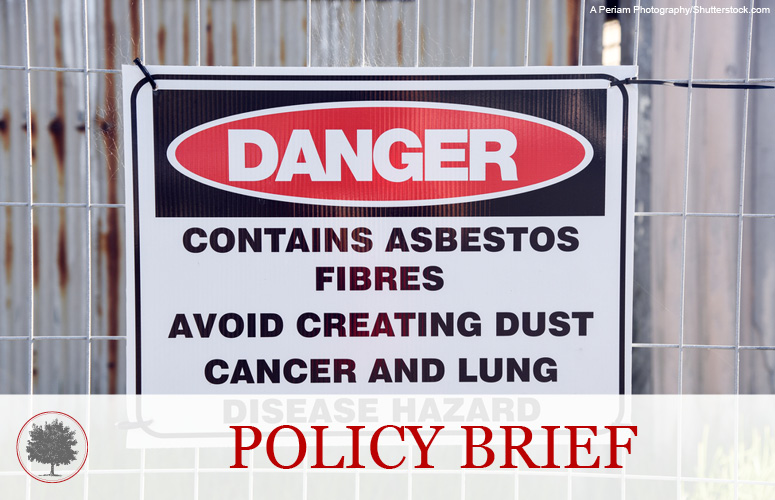Ohio Takes the Lead on Asbestos Reform
Dec 03, 2012
By David J. Owsiany
The American civil justice system is premised on the ability of injured plaintiffs to recover damages from the parties whose actions caused their injuries. In the context of asbestos liability, this enduring concept has been undermined. In many states, courts are clogged with asbestos-related suits, companies are paying for non-existent injuries, and truly sick plaintiffs may be left with nothing to recover in the future.
In response to this crisis, Ohio has become a national leader in reforming the asbestos liability system. And more needs to be done.
The asbestos litigation numbers are startling. Nationally, more than 700,000 plaintiffs have led lawsuits against more than 8,400 companies over the last 40 years. As a result, 85 companies, which manufactured or sold asbestos-related products decades ago, including at least five in Ohio, led for bankruptcy protection. Many of these companies provided huge sums of money to asbestos bankruptcy trusts. This approach made sense for both the companies and the plaintiffs because it reduced costs by avoiding expensive civil trials and expedited recoveries for injured parties. These bankruptcy trusts have transferred tens of billions of dollars from companies and their insurers to plaintiffs and their lawyers.
As asbestos litigation burgeoned over the years, plaintiffs’ lawyers looked for ways to further line their pockets by finding new potential plaintiffs and new companies to sue. Starting in the 1980s, trial lawyers began manipulating the civil liability system by flooding the courts with asbestos claims. Most of the new cases were on behalf of plaintiffs who had been exposed to asbestos but did not have any actual physical impairment from the exposure. Their claims were often against so-called “deep pocket” companies that never had anything to do with asbestos other than buying a small business that produced asbestos-related products decades earlier.
Ohio was a haven for such lawsuits in the early 2000s with more than 40,000 asbestos-related cases. The plaintiffs’ attorneys led these cases hoping to overwhelm the system and force the defendant companies into mass settlements. At the time, former Carter administration Attorney General Griffin Bell said that the most significant casualty of the asbestos liability crisis was fairness itself as non-sick plaintiffs were forcing innocent companies into bankruptcy and depleting reserves, threatening future recoveries by truly sick plaintiffs. It has been estimated that asbestos liability has resulted in the loss of more than 60,000 jobs nationally.
In 2004, Ohio was the first state to address the crisis by requiring plaintiffs to establish certain medical criteria demonstrating actual physical impairment in order to proceed with litigation. As a result, approximately 30,000 cases that were clogging Ohio’s court system were dismissed. The new law, however, did not block the courthouse door to these individuals since their cases could later be re-filed if the plaintiffs began to show physical impairment from asbestos exposure. This reform was significant because it freed up the courts to deal with cases that involved real injuries and helped ensure resources were available for truly injured plaintiffs in the future. Several states, including Florida, Georgia and Texas, followed Ohio’s lead and enacted similar reforms.
Unfortunately, the existing law may not go far enough as trial attorneys are now targeting asbestos bankruptcy trusts for abuse. This situation came to light in a now-infamous case from Cuyahoga County where a plaintiff’s estate sued a cigarette company alleging the plaintiff was injured from smoking the company’s cigarettes, whose filters contained asbestos in the 1950s. Before his death, the plaintiff could not specifically identify how he had been exposed to asbestos so his lawyers led several independent claims with different bankruptcy trusts. Each claim told a different story about the plaintiff’s asbestos exposure, trying to establish separately that each of the companies was responsible for the plaintiff’s death. The plaintiff recovered as much as $700,000 from trust settlements, notwithstanding his estate’s later lawsuit claiming the cigarette company was responsible for his death. The existence of these inconsistent claims only came to light because the judge took the rare step of encouraging disclosure of the prior claims, which were then admitted into evidence.
Because bankruptcy trust filings and settlements are normally confidential, this type of inconsistent ling of claims is usually never detected. Columbus lawyer Richard Schuster, who has represented a number of companies in asbestos cases, contends that the filing of such inconsistent and potentially fraudulent claims “occurs over and over again in the courts of Ohio.”
To remedy this situation, the General Assembly is considering legislation to enhance transparency in the asbestos litigation system, including requiring any plaintiff bringing an asbestos lawsuit to disclose any previous claims filed with asbestos trusts. Greater transparency is necessary to restore fairness, openness and accountability to the asbestos liability system, which has been subject to fraud and abuse for too long.
